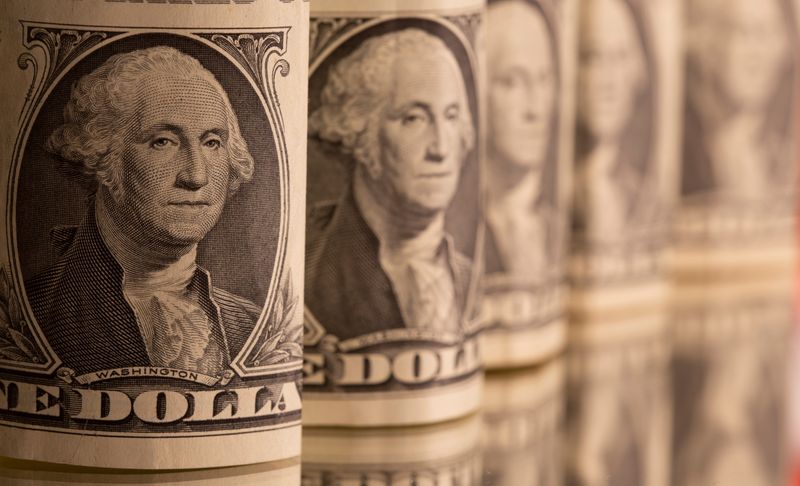By Mike Dolan
LONDON (Reuters) - If there's no taper, why the tantrum?
A surge in government bond yields this month and related wobble in equities has markets harking back to 2013's "taper tantrum" -- when the prospect of the Federal Reserve winding down its bond-buying nearly doubled 10-year U.S. Treasury yields in four months and briefly knocked world shares by 10%.
This year's moves, so far, are less than half that magnitude, and the tentative comparison runs further aground.
Eight years ago, the Fed did indeed signal a tapering of its monthly bond purchases, in place since the 2008 banking crash. This year, there's little or no chance of it doing so. If anything, central banks might double down on easing.
So what's eating the bond market?
There are fears that as the pandemic ends, trillions of dollars of government spending and money creation will reignite inflation to more than the Fed's target of an average 2% rate over time. Until this week at least, bubble-like stock prices and commodities riffed off the stimulus and inflation spin too.
But that's only part of it.
Five and 10-year inflation expectations embedded in bond markets are back up to 2.0-2.5% -- hardly alarming and not unwelcome at a Fed that has struggled to hit its 2% target for much of past decade and, after its recent strategy review, is keen to counterbalance that long undershoot for a period.
What's more, a favoured market gauge -- five-year/five-year forward inflation swaps -- shows expectations almost 75 basis points below the 3% levels hit in 2013 and is now falling back sharply again.
Fed chief Jerome Powell told Congress this week the U.S. central bank was happy to see through a temporary spike in headline inflation to 3% or more later this year, as the economy reopens after the pandemic. A bigger prize was making sure activity recovered enough to get everyone back to work.
Sustainably exceeding 2% inflation beyond the post-COVID bounce may take more than three years, Powell said. Clearly not a man in a hurry to raise interest rates or taper.
Market economists tend to agree on his inflation assessment.
"This is a temporary inflation spike which investors should ignore," said UBS economist Paul Donovan, dismissing an expected spring rise due to base effects from oil prices.
The impact of reopening service sectors like travel and leisure and retail may be more important late this year, he added, but it will be dangerous to read too much into headline inflation anywhere until economies normalise.
SO WHY THE SULK?
In context, nominal U.S. 10-year yields are only back up to where they were 12 months ago -- albeit with trillions of dollars of additional government borrowing to shoulder and despite some $120 billion a month of Fed purchases.
On one hand, it may be no bad thing if higher long rates puncture stock market bubbles. But tighter credit conditions will surely be frowned upon if post-pandemic rehiring slows.
With inflation-adjusted yields at six-month highs too, it's clearly not all about inflation.
And with Treasury bill yields and money market rates pinned to zero by a flood of cash liquidity, it's not due to any short-term credit squeeze. The market is awash with cash -- itself something some inflation hawks fear.
Many are looking at the mechanics of Treasury debt sales.
In preparation for the Biden government's $1.9 trillion of fiscal stimulus, the Treasury is starting to run down its $1.6 trillion bank account at the Fed and pay down hundreds of billions of Treasury bills, leaving shortages of risk-free bills for money funds and rates consequently tethered at zero.
Fewer bill sales relative to longer-term notes and bonds in the Treasury's funding mix partly explains the steepest two-to-30 year yield curve since 2015.
Neil MacKinnon, Global Macro Strategist at VTB Capital, reckons the Fed may be hoping that burgeoning pool of cash migrates down the curve to eventually cap long-term yields -- or that zero bill rates encourage the Treasury to shorten its average maturity to take pressure off the long end.
The bond market could then stabilise itself if the Treasury ups the ratio of bills in its debt raising and the Fed lengthens further the maturity of its bond-buying.
The average maturity of Treasury debt is 65 months, down from 70 months before COVID-19 hit but up from July's trough of 62 and more than two months more than 20-year averages. The average maturity of Fed Treasury holdings is already 89 months.
If the bond market tantrum is more about supply dynamics than Fed tightening or genuine inflation worries, it will be even more fleeting than in 2013.

"It's fair to say that the U.S. reflation trade has got legs in the short term," said Eva Sun-Wai, manager of the M&G Global Government Bond Fund. "But once the noise dies down ... perhaps those legs aren't as long as markets currently think."
(by Mike Dolan, Twitter: @reutersMikeD ; Editing by Catherine Evans)